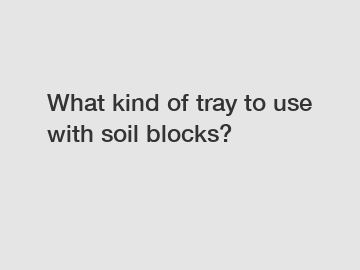What kind of tray to use with soil blocks?
As gardening enthusiasts, we understand the importance of using sustainable, eco-friendly practices to nurture our plants. One such practice gaining popularity among green thumbs is the use of soil blocks for seed starting. Soil blocks offer several advantages over traditional containers, promoting healthier root growth, reducing transplant shock, and minimizing the use of plastic. But what kind of tray should you use with soil blocks? In this blog, we will explore the various options available and help you choose the perfect tray for your soil blocks.
1. Standard Nursery Trays:
Most commonly used for gardening projects, standard nursery trays are an affordable and easily accessible option. These trays typically come with drainage holes, allowing excess water to escape and preventing root rot. However, when using nursery trays with soil blocks, it's essential to place them on a flat surface to avoid any distortion or damage caused by the weight of the blocks.

2. Open Mesh Trays:
Open mesh trays, also known as propagation trays, are designed with built-in mesh bottoms that allow for excellent drainage. This feature enables direct contact between the soil blocks and the surface below, facilitating air circulation and preventing waterlogging. These trays are ideal for growing soil blocks as they promote strong root development and reduce the risk of overwatering.
3. Bottomless Trays:
Bottomless trays, made of rigid plastic or metal, offer a unique approach to soil block gardening. With their lack of a solid bottom, these trays provide optimal airflow to the soil blocks while allowing excess water to drain freely. They can be placed on any surface with ease and offer stability to ensure your soil blocks remain securely in place. Bottomless trays are a versatile option for gardeners seeking efficient drainage combined with convenience.
4. Seedling Flats:
Seedling flats, traditionally used for starting seeds in individual cells, can also be repurposed for soil blocks. These trays offer the advantage of creating individual compartments for each soil block, preventing root intertwining and facilitating transplanting. Seedling flats come in various sizes and can accommodate different soil block configurations, making them a flexible option for gardeners who prefer organized and easy-to-manage seedlings.
5. DIY Options:
Gardening often inspires creativity, and if you enjoy experimenting, you may consider crafting your own trays. Recycled materials such as shallow wooden boxes or cut-up plastic containers can be repurposed into trays by adding drainage holes. Not only does this option promote sustainability, but it also allows you to tailor the tray's dimensions to fit your specific soil block requirements.
Conclusion:
Choosing the right tray for your soil blocks plays a crucial role in their successful growth and development. From standard nursery trays to open mesh trays, bottomless trays, seedling flats, and DIY options, the possibilities are vast. Consider the unique needs of your plants, the space available, and your personal preferences to make an informed decision.
Remember, the ultimate goal is to provide your soil blocks with optimal drainage, adequate airflow, and stability. By selecting the appropriate tray, you are ensuring healthy seedlings that are ready for transplantation and will flourish in your garden.
Embrace sustainable gardening practices and let soil blocks revolutionize your seed-starting process. Happy gardening!
If you want to learn more, please visit our website hydroponic plant trays, best seed starter kits, shallow germination trays.
207
0
0


Comments
All Comments (0)